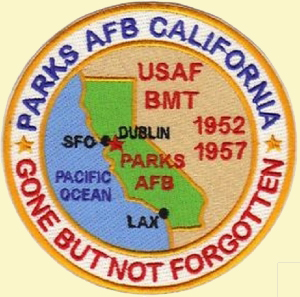|
BOTTOM of Page | BOTTOM
of Page |

|
Parks Air Force Base Summary History The US Navy closed its World War II Seabee base at Camp Parks in late 1946. In August 1951, the 3275th Air Indoctrination Wing started operations at the newly commissioned Parks Air Force Base. Prior to that the Air Force had to completely construct a new base on what was 3,636 acres of mostly, barren ground. Most previous Navy facilities were auctioned off after 1946 and torn down by private parties. Founded to provide basic training to the influx of new airmen for the Air Force’s Korean War response, the facilities were not quite as extensive as the Navy’s Camp Parks. And in what was unusual for an Air Force base, there was no paved runway. Over the next few years thousands of young men received basic training. Adjacent to the base, the Air Force took over the former World War II vintage Navy hospital buildings and renovated them into the regional Air Force hospital. Eventually other units and missions came to the base. In 1953, Air Base Defense classes started as the Air Force transitioned base defense from the Army. The Air Force first terminated basic training and then reinstated it that year, all in response to Defense Department budget problems. In 1956, base operations started to change as basic training and the Air Base Defense School moved to Lackland Air Force Base. In early 1957, the 2349th Air Base Wing and the 2349th Personnel Processing Group started operations as part of the Fourth Air Force. Personnel processing continued as the main base operation until 1959 when the base closed. From 1959 to 1973, Camp Parks went through a period of readjustments as missions were sought, given, changed and modified. For a time the camp was in standby status under the jurisdiction of the US Sixth Army, Presidio of San Francisco. By 1964, the Sixth Army declared the entire installation excess, but the Department of the Army directed that it retain 1600 acres for National Guard and Navy use. In the same period property was transferred to the County of Alameda and used for a variety of activities, one of which was a Job Corps Training Center. From 1965 through 1969, many of the former Air Force buildings were used for vocational training and as residential units for young men living there. By 1973, the U.S. Army determined that Camp Parks was needed as a mobilization and training center for Reserve Components in the event of war or natural disaster. In 1980, the Army officially designated Camp Parks as a semi-active installation, renamed it Parks Reserve Forces Training Area, and declared it a sub-installation of the Presidio of San Francisco. By 1992, Parks became a sub- installation of Fort Lewis, the first of a number of realignments that today is part of the US Army Installation Management Command, Central Region. Throughout the period after 1959 the area around Parks changed dramatically. The community of Dublin grew from a few small farms to a few large housing developments to a small city. Incorporated in 1982, the city of Dublin now has about 50,000 residents. What were once dusty, weed filled fields all around Parks Air Force Base are now filled with condos, townhouses, houses and shopping centers. Steve Minniear, Dublin Historical Preservation Association, September 2016 |
Go to Parks Air Force Base 2 — Your Stories